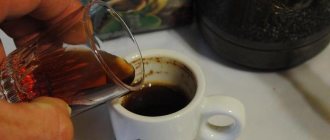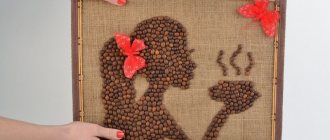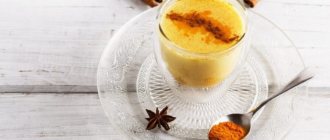Even the most avid coffee lover would hardly be able to list all the varieties of coffee. There are many varieties of coffee beans and drinks based on them. New recipes are constantly being invented. Only by understanding all this abundance will you be able to choose products in accordance with personal preferences and decide on your favorite drinks.
What types of coffee are there?
Varieties and types of coffee are two completely different concepts. By variety we mean all kinds of hybrids that were obtained through selection. In addition, the name “variety” is used to designate coffee products presented on the market. A species is a variety of plants. It is worth considering the most common of them.
Liberica
The plant is called the Liberian coffee tree. The fruits grown on it are exported extremely rarely. As a rule, they are consumed in the country where they grow. This is due to the whimsical nature of culture.
Most plantations are located in Africa. The taste of liberica is bitter, even pungent. Therefore, it is not used to prepare drinks in its pure form, but is added to mixtures. Due to this, they acquire a rich aroma.
Excelsa
It is considered the rarest among the types of coffee crops. He is also called Tall. This is due to the fact that the trees grown reach a height of up to 20 meters. Hand-picked grains have a rich taste and rich aroma.
Arabica
The Arabian coffee tree is considered the most popular. Its fruits are characterized by multifaceted taste and aroma. The culture is capricious and can only be grown in favorable climatic conditions. Sudden changes in temperature at night and during the day are allowed, but frost is unacceptable.
Arabica beans are smooth, long, and contain relatively little caffeine. The drink based on them has a characteristic sourness.
Robusta
The fruits of the coffee tree have a high concentration of caffeine. Due to this, the drink based on them has a bitter taste. As a rule, robusta is included in mixtures to give them strength. The grains are small and have small spots on both sides of the dividing groove.
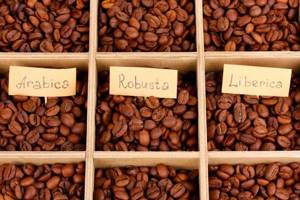
Types of coffee by type of coffee tree
There are several dozen species of coffee tree. According to some data - 50, according to others - almost 90. Of these, only two types of trees - Arabica and Robusta - produce grains suitable for preparing the drink we are familiar with.
Arabica or Arabian coffee
The first coffee was made from Arabica beans approximately 800-900 years ago. Arabica is native to Ethiopia, where coffee trees still grow in their natural form. Arabica was actively distributed to different countries, but acclimatization of a capricious foreigner was not an easy task. Either the climate is unsuitable, or diseases destroy entire plantations.
The trees bear fruit all year round. The grains have a strong aroma. Beans grown in valleys or on low slopes have higher caffeine content than high mountain varieties.
Robusta
Congolese coffee.
It became known much later than Arabica. It has a rough, bitter taste and high caffeine content. Arabica is much more resistant to temperature fluctuations and diseases. Therefore, many modern coffee varieties are a hybrid of Arabica and Robusta. Large beans of another coffee tree, liberica, also produce coffee, but of poor quality. Liberica has no industrial significance, but some originals include these grains in mixtures.
What varieties are there?
If there are only four types of coffee, then there are significantly more varieties. The list of the most popular includes products grown in South America and Africa.
Brazilian bourbon santos
It is considered the most common among coffee varieties. Trees are grown in Brazil. The drink based on these grains has a chocolate flavor. It contains notes of citrus and almond.

Maragogyp
The most famous variety. The grains are famous for their large size. The drink is aromatic and quite thick. It has a pleasant sweetness. The fruit is grown in Brazil, Mexico and Guatemala.
Medellin
The fruits undergo careful selection before being exported. Therefore, deformed, bad copies do not go on sale. The taste of the prepared coffee is multifaceted and rich.

Colombia Excelso
This variety of coffee beans has a slightly noticeable bitterness and a pronounced cocoa flavor. It is valued by gourmets for its pleasant, unobtrusive sourness. The drink turns out rich, but at the same time delicate.

Maracaibo
The characteristics of the variety grown in Venezuela are not inferior to the Colombian varieties. The drink contains hints of dry wine. There are no analogues to Maracaibo in the world. Therefore, it is often sold at auctions.
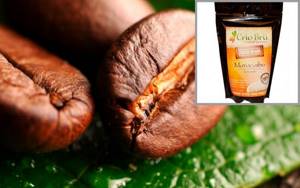
Oksaka
The plantations are located in Mexico. The drink based on these grains has a multifaceted taste. It contains shades of nuts and vanilla. There is a slight bitterness.
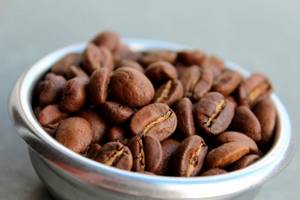
Antigua and Cobano
These varieties are grown in Guatemala. They are valued primarily for their strength, which gives a charge of vigor. In addition, many coffee lovers prefer these varieties due to the presence of pleasant sourness in the drink.
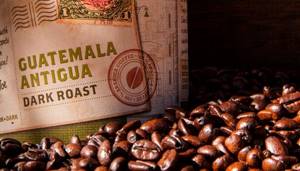
El Salvador Chalatenango
The variety grown in Brazil can easily be called exquisite. It is characterized by an almond flavor and an unobtrusive floral aroma. Thanks to these properties, it has gained immense popularity.
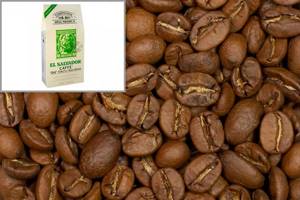
Ethiopia Mocha
It is considered one of the best varieties. Gourmets call its main advantages a pleasant fruity-wine flavor and an unobtrusive but long-lasting apple aftertaste.
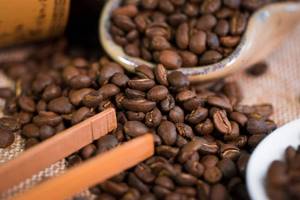
Yemen Moha
The plantations where this type of coffee bean is grown are located on the volcanic slopes in Yemen. A drink based on them is characterized by the presence of sourness and a fruity, sweetish aroma.

Classification of coffee by variety
There are a huge number of varieties based on Arabica, Robusta and their hybrids in the world. It is impossible to list everything, but the varieties can be divided into two large groups.
- Widespread varieties. For example, Bourbon, Antigua, Supremo, Santos. The same variety can be grown in different countries, such as Brazil, Vietnam and Indonesia. In this case, its origin is added to the name of the variety. For example, Peaberry Tanzania or Maragogyp Brazil.
- Exclusive monovarietals , which are produced in a certain area or using a certain technology. For example, Malabar Monsoon is Indian coffee with partial fermentation under the influence of monsoon winds, and Old Java is artificially aged Indonesian coffee.
Types and recipes of coffee drinks
It is quite difficult to understand from pictures and photographs what is included in a particular drink. It is much easier to understand if you study their detailed description.
Espresso
This type of coffee can be called a classic. The coffee drink is prepared in a special coffee machine. At the same time, only 30 ml of water is consumed for 7 g of crushed dark roasted beans. Espresso is served in small ceramic cups. It turns out strong, dense, with thick foam. Many other drinks are prepared on its basis.
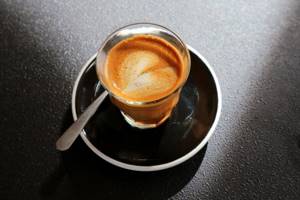
Romano
This coffee drink will appeal to connoisseurs of sourness in coffee cocktails. It is prepared by mixing a standard shot of espresso with two tablespoons of lemon juice. Romano is served in small cups. A slice of lemon serves as decoration.

Ristretto
The method of preparing ristretto is similar to espresso. The only difference is the use of less water. Only 25 ml is consumed per serving. This strong drink with a thick consistency is drunk in one sip. It is customary to drink it with cold water. This coffee option is especially popular among Italians.
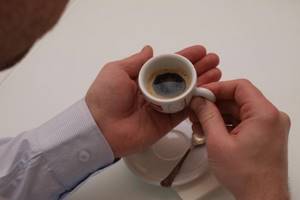
Mocha
Prepared on the basis of espresso. The list of ingredients also includes:
- chocolate;
- whipped cream;
- milk.
All products are taken in equal proportions (30 ml each).
Making mocha at home is easy. To do this you need to perform several steps:
- Melt the chocolate in a water bath and pour into a glass.
- Immediately after brewing the coffee, pour the hot espresso over the chocolate.
- Warm the milk a little and add to the composition.
- Spread whipped cream on top of the surface.
All components are placed in layers. Mocha has amazing taste and aroma properties. It belongs to the group of sweet desserts.
Latte
Latte is an espresso-based drink. When preparing it, two parts milk is used to one part black coffee. The following actions are performed:
- The milk is divided into two equal parts.
- One half of the milk is simply heated, and the other half is whipped to obtain foam.
- A portion of heated milk is poured into a tall glass goblet.
- Immediately after this, add espresso.
- Milk foam is spread over the coffee.
Syrups can be added to the composition. The surface is often decorated with a pattern. Latte is served in 450 ml glasses. Drink a cocktail through a straw.

Macchiato
In fact, this is one of the variations of coffee with milk. The recipe for making macchiato is incredibly simple. You just need to do a few steps:
- Brew espresso in a coffee maker.
- Pour the hot drink into the cup.
- Place whipped milk on top.
It is not customary to add sugar to the composition.

Cappuccino
Cappuccino is also prepared by first brewing espresso coffee. Milk is used for preparation. They take products in the same ratio as in the case of a latte. The only difference is that espresso is poured into the cup first. After this, add a portion of regular milk, and spread whipped milk foam on top.
Cappuccino does not imply mixing all the ingredients, they must be placed in layers
Viennese coffee
Already from the name it becomes clear that this drink is considered traditional in Austria. It is an espresso with cream and is valued for its rich aroma and delicate taste. When preparing it, the following steps are performed:
- Brew black coffee and pour into a glass.
- Spread whipped cream on top.
- The surface is decorated with chocolate chips, cinnamon or vanilla.
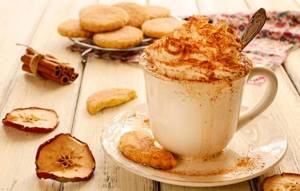
Irish
The preparation of this cocktail is somewhat different from the traditional one. Add 20 ml of whiskey to a shot of hot espresso. The surface is decorated with whipped cream. Sugar is usually not added to the composition. Various toppings can be used. For example, creamy or chocolate.

Americano
It is especially popular due to the lack of characteristic coffee bitterness. Americano is quite light, not strong. To prepare it, you first need to brew a shot of espresso and then add 90 ml of water to it. You can also add sugar to taste. Dessert or cookies are usually served with coffee.

Frappe
This is one of the few famous coffee drinks that uses instant coffee in its preparation. Frappe is especially popular in Greece. To prepare it, follow a number of simple steps:
- Pour a couple of tablespoons of coffee powder into a shaker.
- Pour in 200–300 ml of water.
- Add sugar.
- Then add ice cubes to the shaker.
- The resulting mixture is vigorously whisked and poured into a glass.

Glyase
Refers to those drinks that are served chilled. The recipe for making glace comes down to just a few steps:
- Brew classic espresso.
- After cooling, the coffee is poured into a cup.
- Place a ball of ice cream on top.
- The surface of the ice cream is sprinkled with chocolate chips.

Honey raf
Raf coffee was invented in one of the Russian coffee shops about twenty years ago and in a short period of time gained popularity all over the world. The process of preparing it is quite simple:
- Add cream (100 ml) and honey (to taste) to hot espresso.
- The resulting mixture is whipped with a cappuccino maker.
- Whipped milk foam is carefully placed on top of the surface.

Torre
This drink is also based on a shot of espresso. Quite dense milk foam is placed on top of it. It should rise above the cup by about a couple of centimeters. Torre is served in cappuccino cups.
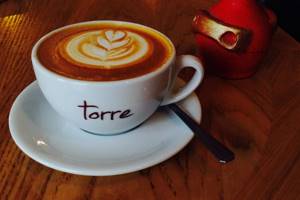
Roasting degree
There are many different names to determine the type of roast: light, medium, Viennese, City plus, filter, blonde...
You must understand that roasting is a process that unlocks the existing flavor and aroma potential of coffee beans. However, if you roast the grain incorrectly, it will introduce additional unnecessary flavors that will overwhelm the characteristics of the grain. Undercooked grain will be grassy and sour. Over-roasted coffee will taste bitter, smoky, and unpleasant.
Specialty coffee connoisseurs prefer light roasts, but the fact is that the best roast depends on the bean itself, the preparation method and, of course, consumer preferences. Let's see why.

Two packs of single origin coffee: KENYA BARAGWI and GUATEMALA – SAN FLORENCIO, roasted under filter www.aprilcoffeeroasters.com ©Ana Valencia
Light roast
Also known as cinnamon, blonde, City and City Plus - primarily for medium-light roasts.
These profiles are known to highlight fruity and acidic notes in flavor and aroma and are therefore suitable for coffees that already have these characteristics. Some people argue that light roasts are less sweet, but this is not always the case. Because high-quality specialty coffee is prized for its complex profile, many roasters opt for a light or medium-light roast to highlight this.
Dark roast
In other words, Vienna or Light French, while Full French and Italian are considered very dark roasts.
When you drink dark roast coffee, you can taste the roasting process itself—roasty, bitter, and full-bodied. Dark roast has a bad reputation among specialty coffee drinkers and is sometimes used to hide imperfections in the bean.

Range of roast types ©Starbucks
Medium roast
Also known as Full City, the slightly darker-than-medium roast is called Full City Plus.
Why did we put the description about medium roast after light and dark, instead of in the middle? Because a medium roast is largely defined by what it isn't—it's neither light nor dark. Instead, think about balance, body, profile, characteristics that don't overshadow the coffee's natural flavors and aromas.
Espresso, Filter and Omni
espresso roasts are slightly darker than filter . (This is the difference between dark and light roasts.) Omni roasting, in turn, is intended for both filter coffee and espresso.
So why are the roast profiles different for espresso and filter? Because espresso is an intense brewing method well suited for sweet, full-bodied coffee, while filter coffee is generally known for its complexity and uniqueness.
Similarities and differences between drinks
The basis of coffee drinks is usually espresso. However, they differ from each other in the method of preparation and additional ingredients. For example, latte, cappuccino and macchiato are prepared using the same ingredients, but there are differences between them. Recipes imply different procedures.
In a latte, the first layer is milk, followed by espresso and milk foam. Coffee is initially added to cappuccino. Then add warm milk, which is covered with foam. A macchiato uses only espresso and frothed milk.
Even regular black coffee will be called differently depending on the volume and the presence of additional components. The standard portion of a drink (30 ml) prepared in a coffee machine is espresso. If you reduce the amount of water a little, it will be ristretto, and if you add lemon juice, it will be romano.
Types of coffee drinks: photos with names and descriptions
Brazilian coffee beans are used to prepare a variety of drinks - both pure coffee drinks and those with the addition of milk, cream, syrups, ice cream, and alcohol. All drinks are prepared using strong espresso. Doppio is a double espresso.
To get another drink, you need to add the following ingredients to one part of espresso:
- Americano - two parts water;
- Cappuccino - one part hot and two parts frothed milk;
- Latte - two parts hot and one part whipped milk;
- Viennese style - two parts of whipped cream;
- Mochaccino - one part each of hot chocolate and whipped milk;
- Mocha - one part each of hot chocolate, milk and whipped cream.
A large assortment of coffee types allows you to choose the perfect drink for every day and combine the most unexpected tastes.
Equipment for preparing coffee drinks
Classic coffee is prepared in a cezve. Coffee beans were brewed in it long before coffee machines were invented. This vessel with a narrowed neck is still used today. An alternative option is a French press. It manages to prepare a fairly strong, aromatic drink. It works on the principle of a press. After infusion, coffee powder is squeezed out in it.
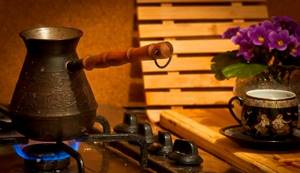
Additional accessories include:
- coffee grinder - can be electric or manual;
- pitcher - designed for frothing milk;
- espresso shot - is a measuring cup that is used when preparing espresso;
- tamper - presses coffee powder when brewing a drink in a coffee machine;
- shaker - used when necessary to mix ingredients.
Unusual devices may also be used. Among them:
- Chemex. It consists of a flask and a funnel connected by a leather rim.
- Purover . The design consists of a funnel with a spiral bottom and a base that is placed on a cup.
- Aeropress . A relatively new invention that is placed on a mug with the filter facing down. Coffee powder is placed in it and water is poured in. The thicket is pressed down with a press.

Aeropress
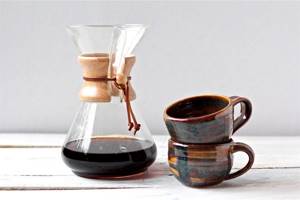
Chemex
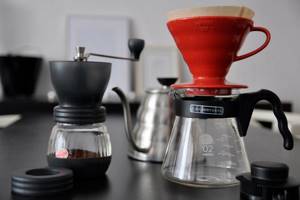
Understanding all types of coffee is not as difficult as it might initially seem.
Knowing its main types and varieties, you will be able to choose the ideal option for yourself and fully enjoy the taste and aroma of your favorite drink.
Types of coffee by type of bean processing
After the coffee is collected from the trees, it is subjected to primary processing. It comes in different types, and is also the subject of classification.
- Wet processing . It is produced by washing the grain and then soaking it for a while. The grains are then washed and dried again. With this treatment, primary fermentation of the grain occurs, it becomes elastic and soft.
- Dry processing . This method is also called natural. The grains are washed, dried, and then winnowed to remove any remaining pulp. Dry processed coffee has a more expressive and pungent taste, closer to the natural bouquet of the variety.
